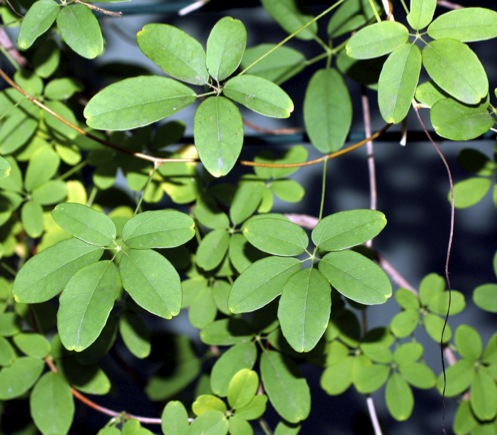 Download PDF
Download PDF
Name: Akebia quinata (Houtt.) Decne.
Family: Lardizabalaceae
Common Names: Chocolate Vine (1), Fiveleaf Akebia (2), Akebia (17), Akebi (Japan, 14).
Etymology: “Akebia” comes from the Japanese name for the plant (Akebi) (14). Quinata, Latin, comes from ‘quin’: it is in the possessive form implying ‘has five of something’, in this case leaflets (11). The Lardizabalaceae is named for Miguel de Lardizabel y Uribe, a Spanish naturalist of the 1700s (12).
Botanical synonyms: Rajania quinata (Houtt.), Akebia micrantha (Nakai) (10).
Quick Notable Features:
- Pendant inflorescence
- Palmately compound 5-foliate leaf (uncommon among vines)
- Notched tip on leaflet (distinguishes leaflet from the leaves of many Rhododendrons)
Plant height: Up to 20m long, usually between 8 and 15m (7).
Subspecies/varieties: Akebia quinata var. polyphylla (Nakai) and Akebia quinata var. yiehii (W.C. Cheng) (10). It has also been crossbred with Akebia trifoliata (Thunb.) to create Akebia x pentaphylla (Makino) (1).
Most likely confused with: Wisteria frutescens, Wisteria sinensis, and members of the genus Rhododendron.
Habitat Preference: It is most often found on forest margins, especially along streams. It is also found on mountain slopes (1). It prefers loamy clay soils and full sunlight (16).
Geographic Distribution in Michigan: As of this writing, found naturalized only in Washtenaw County in Southeast Michigan in one collection in Ann Arbor (1), and cultivated in Ann Arbor (R.J. Burnham, pers. obs.).
Known Elevational Distribution: In Japan, Akebia quinata is described as growing in “lowlands.” What “lowlands” specifies is not quite clear (7). In China, the elevational distribution is between 300 and 1500 meters (10).
Complete Geographic Distribution: Native to Japan, Central China, and Korea (2). Akebia quinata is generally found in the United States east of the Mississippi, including Connecticut, Georgia, Illinois, Indiana, Kentucky, Maryland, Massachusetts, Michigan, North Carolina, New Jersey, New York, Ohio, Pennsylvania, Rhode Island, South Carolina, and Virginia, as well as in the District of Columbia, Louisiana and Missouri (1). It is classified as invasive in Kentucky, Maryland, New Jersey, Pennsylvania, Virginia, and District of Columbia (2).
Vegetative Plant Description: A woody, monoecious vine that also appears as a creeper (4, 5). It is semi-evergreen and perennial, but mostly deciduous. Its stems are grayish brown with prominent lenticels (10). Leaves are five-foliate, palmately compound, and arranged alternately along the stem; leaves and leaflets are petiolate and estipulate (4, 6). The leaflets are oblong to ovate-elliptic with a rounded base. Lateral leaflets are from 0.7 to 8.2 cm long and 0.4 to 4.2 cm wide; terminal leaflets are approximately 2.5 to 5 cm long (no description for the width). The petioles are 4.5 to 10cm long (10).
Climbing Mechanism: Akebia quinata is an apical twiner (4); it twines dextrally with its main stems (from left to right as it ascends).
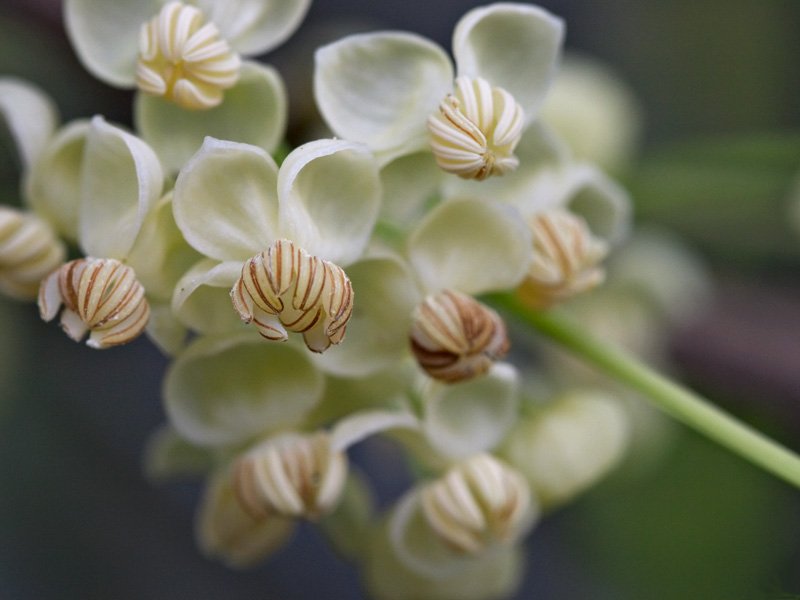 Flower Description: Flowers are produced in a pendulous, racemose inflorescence, and an individual plant can simultaneously produce hundreds of flowers (7). These flowers, both male and female, are radially symmetrical and apetalous (5, 18). Flowers that are staminate (male) are found in a terminal position and are trimerous. They have six or seven incurved stamens, short filaments, and oblong anthers (10). Pistillate (female) flowers are proximal in the raceme; each has four to nine divergent carpels (5), and each carpel secretes a large, viscous drop of fluid that receives pollen (4). Female flowers have three to five sepals that are colored purplish brown to reddish white (and occasionally green) (2, 4, 10, and a superior ovary (18). They have no nectaries, nor has nectar been observed. The flowers have a sweet scent (noted to be like chocolate, 2). The female flowers are significantly larger than the male flowers, about twice as large (3, 5). The calyx on female flowers is about 2cm; male flower calices are approximately 1cm.
Flower Description: Flowers are produced in a pendulous, racemose inflorescence, and an individual plant can simultaneously produce hundreds of flowers (7). These flowers, both male and female, are radially symmetrical and apetalous (5, 18). Flowers that are staminate (male) are found in a terminal position and are trimerous. They have six or seven incurved stamens, short filaments, and oblong anthers (10). Pistillate (female) flowers are proximal in the raceme; each has four to nine divergent carpels (5), and each carpel secretes a large, viscous drop of fluid that receives pollen (4). Female flowers have three to five sepals that are colored purplish brown to reddish white (and occasionally green) (2, 4, 10, and a superior ovary (18). They have no nectaries, nor has nectar been observed. The flowers have a sweet scent (noted to be like chocolate, 2). The female flowers are significantly larger than the male flowers, about twice as large (3, 5). The calyx on female flowers is about 2cm; male flower calices are approximately 1cm.
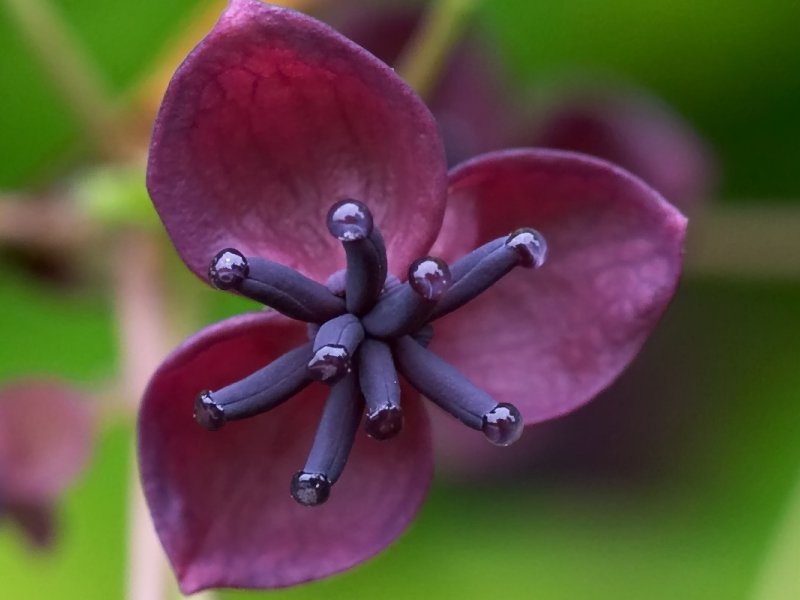 Flowering Time: Soon after spring growth (4), during early April to early May (in central Japan, 5). The female flowers (within an inflorescence) open a few days earlier than the males; there is usually a week overlap in the male and female flowering periods (4, 15).
Flowering Time: Soon after spring growth (4), during early April to early May (in central Japan, 5). The female flowers (within an inflorescence) open a few days earlier than the males; there is usually a week overlap in the male and female flowering periods (4, 15).
Pollinator: The coloration of the sepals suggests fly pollination. The lack of notable nectar, however, as well as the downward-facing flowers and dry powdery pollen, suggest wind-dispersal (4). Two studies observing visitors to the flower noted that it mainly attracted hoverflies and bees (7, 15). In cultivation, however, it may be necessary to hand pollinate (13).
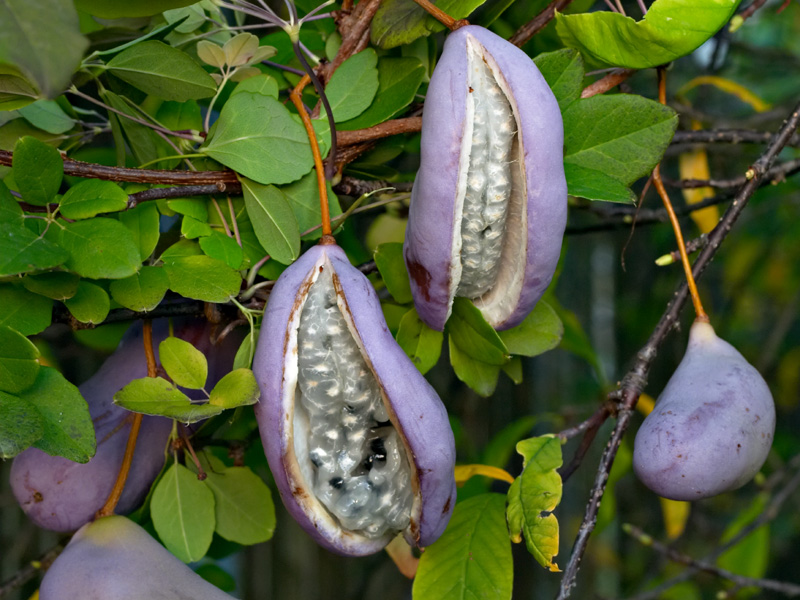 Fruit Type and Description: Berry-like (but not a berry) and moist, the fruit is a purplish gray follicle. The fruits are 5cm – 11cm in length and mature in September to October. Each fruit has a white inner pulp that encases up to 200 seeds (2, 4).
Fruit Type and Description: Berry-like (but not a berry) and moist, the fruit is a purplish gray follicle. The fruits are 5cm – 11cm in length and mature in September to October. Each fruit has a white inner pulp that encases up to 200 seeds (2, 4).
Seed Description: Seeds are tiny and shiny, either brown or black (2).
Dispersal Syndrome: Dispersal of Akebia may be through birds, although widespread dispersal may be through human activity (2). The Akebia fruit is a follicle: its fruit splits open naturally and the plant could also self-disperse. No detailed dispersal syndrome was located.
Distinguished by: The leaf organization (palmately compound) immediately distinguishes Akebia quinata from many look-alikes, particularly Wisteria species, whose leaves, although alternate, are pinnately compound. Akebia can further be distinguished from Wisteria by its notched, elliptical leaflets. This, coupled with its vine habit and compound leaves, distinguishes it from the genus Rhododendron.
Other members of the family in Michigan: None (1).
Ethnobotanical Uses: The dried stems were traditionally used in China and Japan as a diuretic, as an analgesic, and to counteract inflammation (3).
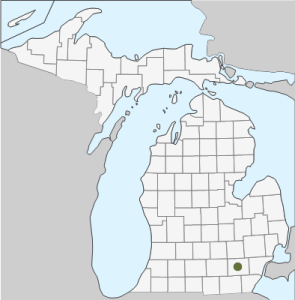 Phylogenetic Information: Lardizabalaceae, Berberidaceae, and Ranunculaceae are generally considered “the core of the order Ranunculales”, but research into their pollen morphology “does not support a close relationship” between them. Research actually demonstrates Lardizabalaceae is quite close to the Sargentodoxaceae family, and the genus Sargentodoxa is sometimes even put into the Lardizabalaceae family, Sargentodoxa being another traditionally medicinal plant with similar uses as Akebia quinata (8). Lardizabalaceae is also very close to the Circaeasteraceaes, an even smaller family only found in and around southern China (9).
Phylogenetic Information: Lardizabalaceae, Berberidaceae, and Ranunculaceae are generally considered “the core of the order Ranunculales”, but research into their pollen morphology “does not support a close relationship” between them. Research actually demonstrates Lardizabalaceae is quite close to the Sargentodoxaceae family, and the genus Sargentodoxa is sometimes even put into the Lardizabalaceae family, Sargentodoxa being another traditionally medicinal plant with similar uses as Akebia quinata (8). Lardizabalaceae is also very close to the Circaeasteraceaes, an even smaller family only found in and around southern China (9).
Interesting Quotation or Other Interesting Factoids: Genera in Lardizabalaceae have quite divergent leaf morphology. Although three different types of leaf forms occur in the separate genera, all have a similar vascular anatomy. These patterns are most notably similar in the rachis and area from node to petiole (6). The fruits are edible and noted to taste sweet. The stems are used for wickerwork (13). It was introduced to the United States as an ornamental in 1845 (2).
Literature and websites used:
- USDA, NRCS. 2001. The PLANTS Database, Version 3.1, National Plant Data Center, Baton Rouge, LA 70874-4490 USA. http://plants.usda.gov/
- Swearingin, J.M., A. Reese, and R. Lyons. Plant Conservation Alliance. http://www.nps.gov/plants/alien/fact/akqu1.htm
- Choi, J.W., H.J. Jung, K.T Lee, and H.J. Park. 2005. Antinociceptive and anti-inflammatory effects of the saponin and sapogenins obtained from the stem of Akebia quinata. Journal of Medicinal Food 8 (1):78-85.
- Payne, W. and J.L. Seago 1968. Open conduplicate carpel of Akebia quinata (Berberidales – Lardizabalaceae). American Journal of Botany 55 (5):575-581.
- Kawagoe, T. and N. Suzuki 2005. Self-pollen on a stigma interferes with outcrossed seed production in a self-incompatible monoecious plant, Akebia quinata (Lardizabalaceae). Functional Ecology 19(1): 49-54.
- Hara, N. and M. Sugiyama 1988. Comparative study on early ontogeny of compound leaves in Lardizabalaceae. American Journal of Botany 75(10): 598-605.
- Kawagoe, T. and N. Suzuki 2003. Flower-size dimorphism avoids geitonogamous pollination in a nectarless monoecious plant Akebia quinata. International Journal of Plant Sciences 164 (6) 893-897.
- Nowicke, J. and J. Skvarla 1982. Pollen morphology and the relationships of Circaeaster, of Kingdonia, and of Sargentodoxa to the Ranunculales. American Journal of Botany 69(6): 990-998.
- Stevens, P.F. Angiosperm Phylogeny Website. Version 7, May 2006.
http://www.mobot.org/MOBOT/research/APweb - Flora of China http://www.efloras.org/florataxon.aspx?flora_id=2&taxon_id=200008288
- Griffith, C. Dictionary of Botanical Epithets. December 30 2005. http://www.winternet.com/~chuckg/dictionary.html
- Plants and Their Names: A Concise Dictionary. New York: Oxford University Press.
- The New Garden Encyclopedia. New York: WM. H. Wise and Co, Inc.
- The International Plant Names Index. http://www.ipni.org/index.html
- Kawagoe, T. and N. Suzuki 2002. Floral sexual dimorphism and flower choice by pollinators in a nectarless monoecious vine Akebia quinata (Lardizabalaceae). Ecological Research17 (3):295-303.
- Missouri Botanical Garden Kemper Center Plantfinder. http://www.mobot.org/gardeninghelp/plantfinder/serviceplantfinder.shtml
- Plants For A Future. http://www.pfaf.org/database/plants.php?Akebia quinata
- Wen, X. Interactive Keys by eFloras. http://www.efloras.org/florataxon.aspx?flora_id=1001&taxon_id=10477
Image Credits (all used with permission):
1. The images of the vegetative plant is copyright Robyn J. Burnham, University of Michigan.
2, 3 & 4) The images of staminate flowers, pistillate flowers, and fruit are copyright Daniel Mosquin, University of British Columbia Botanical Garden. Note that the white flower is a cultivar.
5. Species distribution map, derived from the Michigan Flora Online.
PRIMARY AUTHOR: ReBecca Sonday, with small adjustments from John Bradtke and Robyn J. Burnham.
© Robyn J. Burnham, University of Michigan
For additional information on Michigan Plant Diversity web pages please contact Robyn J. Burnham via email: rburnham“at”umich.edu
